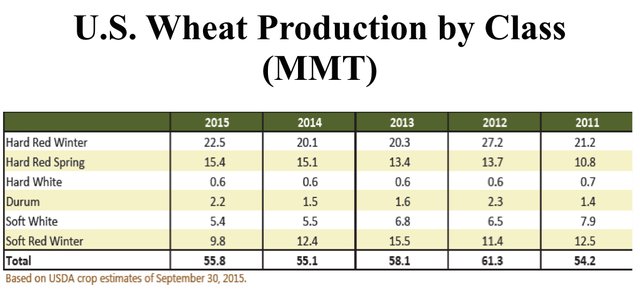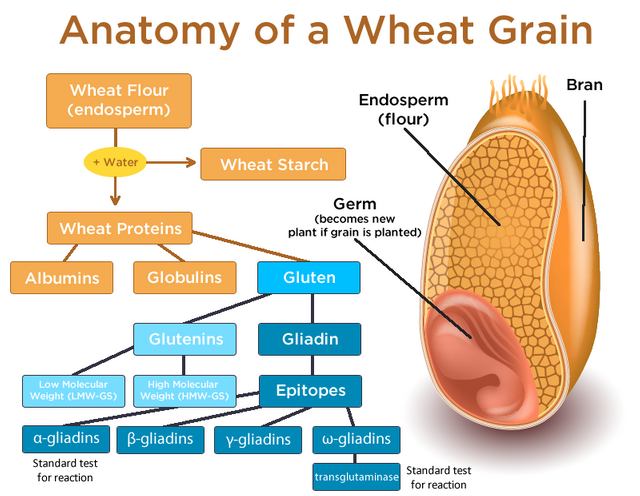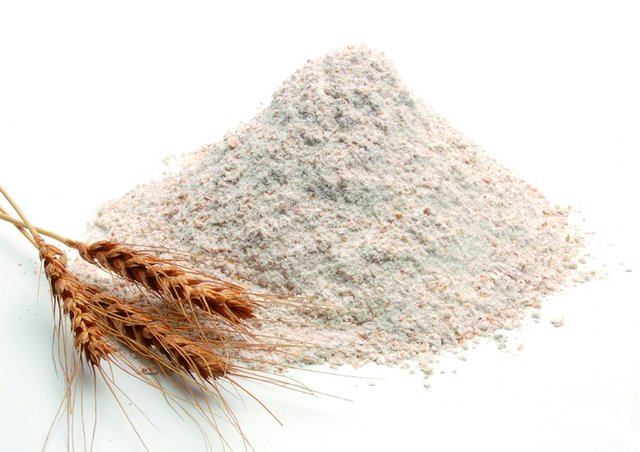What is wheat flour?
Wheat flour (Triticum aestivum) is made from the milling of wheat and is used for human consumption. Wheat flour is the most produced among all flours.
It is the most important ingredient in the bakery. It provides volume and structure to most bakery products: cakes, breads, cookies and fine pastry. While the domestic cook depends almost exclusively on a product called "flour for general use", the professional baker has a large quantity of flour of different qualities. If you want to select the right flour for each product and handled correctly, you must know the different types of flour and how they are ground.
Types of wheat
The characteristics of the flour depend on the kind of wheat from which it is obtained, the place where it was grown and the conditions of its growth. For example, in the United States, wheats are used:
Hard red spring.
Hard winter red.
Soft red winter.
Moruno
Alba or white.

Structure of the wheat grain.
The wheat grain has three fundamental parts:
The bran: is the hard outer covering of the grain. It is present in whole wheat flour in the form of small brown flakes, but is eliminated in the milling for white flour.
The germ: is the part of the grain that will become the new wheat plant if the grain starts to germinate. It has a high fat content that becomes rancid easily. Therefore, the whole wheat flour that contains the germ lacks adequate characteristics for its conservation.
The endosperm: is the part of the grain that contains starch that remains after removing the bran and germ. It is the part of the wheat grain that is milled to obtain white flour.
The endosperm of wheat, depending on its origin, can contain 63 to 73% of starches and 7 to 15% of proteins, smaller amounts of moisture, fat, sugar and minerals.

The grinding of wheat.
The current milling of wheat to turn it into flour is achieved through a rather complex and refined system that uses wheels or grooved steel cylinders. The "crushing" of the grain is done by spacing the wheels at a distance slightly less than the width of the grains and causing them to rotate at different speeds. When passing the grain between the molars, they remove the bran and germ, and grind the endosperm. It is possible to separate approximately 72% of the endosperm from the wheat grain and then turn it into flour. The remaining 28% is made up of the bran and other portions called "husk". The inner parts of the endosperm tend to break into smaller pieces than the outer ones, so that different kinds of flour can be obtained from a single type of wheat by repeatedly crushing it.
The term extraction means the portion of the endosperm that separates to obtain a special kind of flour. For example, a flour with an extraction of 90% consists of the entire endosperm minus 10%.

Types of wheat flour
After having read about the extraction of wheat, we will see how different types of wheat flour are processed. Let's understand that the protein is the gluten in each flour.
- Normal flour (flour "0000"): Between 5 and 10 gr protein per 100 gr of flour.
This flour is ideal for confectionery, it is a weak or low gluten flour, made with soft wheat. Its texture is soft and smooth, pure white. It is a flour that is used for cakes and other delicate bakery products that require a low gluten content.
- Flour with baking powder ("0000"):
It is a white flour to which baking powder is added and, in some cases, salt. It has the advantage that the baking powder is mixed uniformly. However, its use is limited by two factors: first, the different formulas require different proportions of baking powder; Second, the baking powder loses its leaching power over time, so that the quality of the products prepared with this flour can vary.
- Whole or whole wheat flour:
This flour is prepared by grinding whole wheat grains, including bran and germ. The germ, as I mentioned, has a high fat content that can become rancid. For this reason, whole wheat flour is not as well preserved as white flour. Since it is also made from wheat, this flour contains gluten, so it can be used alone in baking. However, a bread made with 100% whole wheat flour is heavier than white bread because the gluten fibers are cut with the sharp edges of the bran flakes. In addition, the fat that contains the germ contributes to the shortening action of the gluten fiber.
For this reason, most whole wheat breads are reinforced with white flour to achieve good baking.
- Bran flour:
It is a flour to which the bran husk is added. The bran can be rough or fine, depending on the specifications.
- Force flour (flour "00"): of 11.5 gr. at 13.5 gr. of proteins per 100 gr. Of flour
This flour is ideal for bakery, it is a flour with a lot of strength made with durum wheat. It is a flour that is used for bakery.

Enzymes in flour
A minor but important component of wheat flour is a group of enzymes called diastase. These enzymes convert part of the starch into sugars that can be modified by the yeast. If a particular flour is low in diastase, these enzymes may be added by the miller.
I grew up on a farm where my father raised primarily soft white wheat, which is used primarily for noodles.
Thanks for an informative article.
Thats nice! And thanks to you for taking a time and reading my post, I'm glad you liked it.
thank you so much for your useful article
Congratulations @albertocotua! You have completed some achievement on Steemit and have been rewarded with new badge(s) :
Click on any badge to view your own Board of Honor on SteemitBoard.
For more information about SteemitBoard, click here
If you no longer want to receive notifications, reply to this comment with the word
STOP